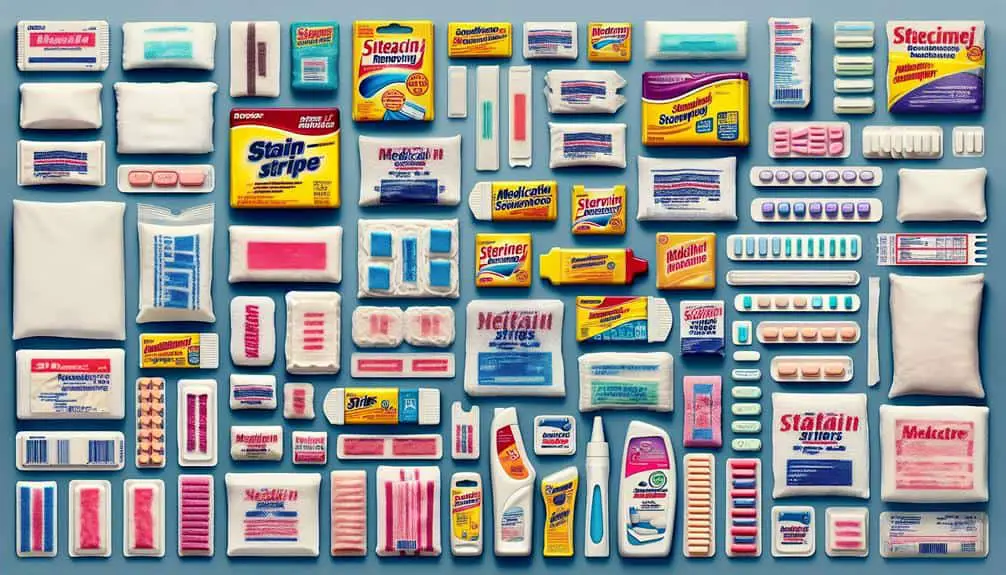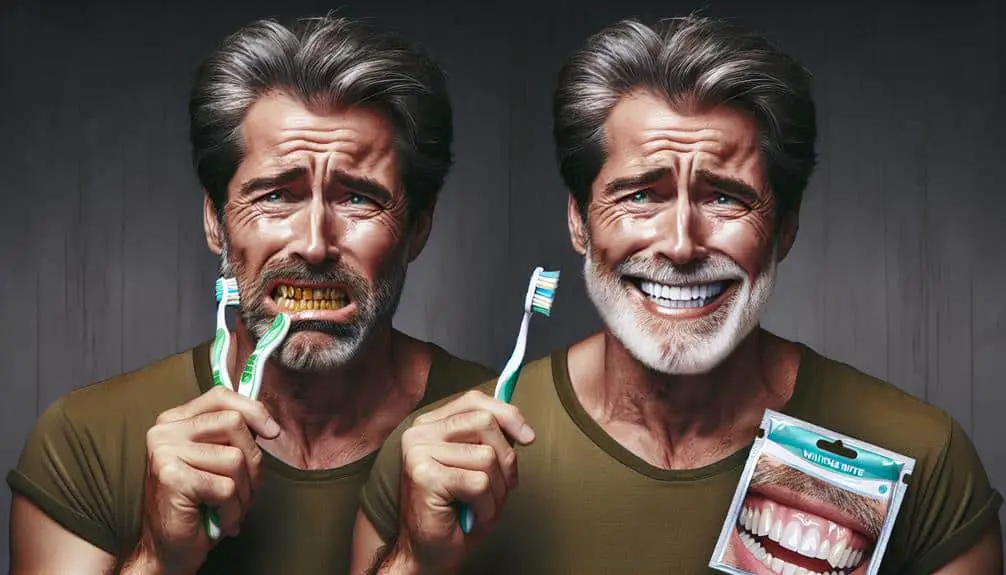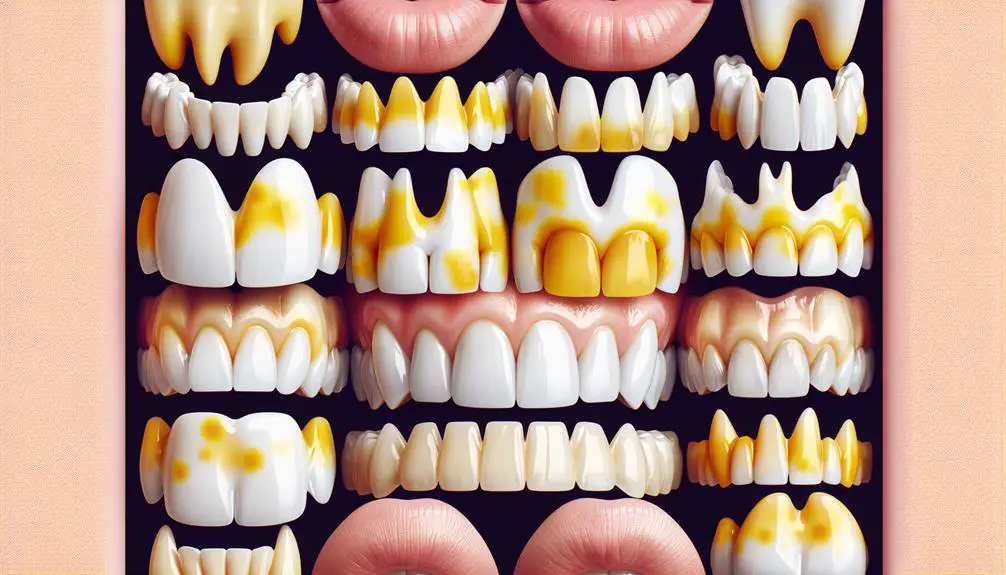To effectively address medication stains, opt for strips specifically designed to lift and prevent discoloration. These strips are crucial for restoring your garments' original look and maintaining their freshness. Look for strips with potent agents that can tackle stubborn stains effectively. Choose ones with stain prevention properties to guard against future discoloration. The right selection can create a barrier repelling stains for longer garment freshness and restoring the fabric's appearance. Make sure you pick strips that suit your needs for best results.
Key Points
- Choose whitening strips with powerful agents to lift medication-induced stains effectively.
- Opt for strips with stain prevention properties for long-lasting protection against discoloration.
- Look for strips that create a barrier to repel stains, ensuring garment freshness.
- Select strips that restore fabric's original appearance for optimal stain removal.
- Ensure proper application by pressing firmly, avoiding air bubbles, and following recommended usage for best results.
Understanding Medication Stains
If you've ever noticed discoloration or stains on your clothing from medications, understanding why this happens can help you prevent future incidents. The most common culprits for medication-induced stains are ingredients like iron, which can react with the fabric and lead to discoloration.
To prevent discoloration, it's important to follow specific steps. To start with, always read the medication labels and any accompanying leaflets for information on potential staining. Next, if the medication is in liquid form, make sure it's completely dry before putting on your clothes to avoid transfer. Additionally, consider using protective layers like napkins or tissues between the medication and your clothing.
If staining does occur, immediate action is vital for effective stain removal. Rinse the stained area with cold water as soon as possible to prevent the stain from setting. Avoid rubbing the stain vigorously, as this can worsen the situation. For stubborn stains, consider using specialized stain removers or seeking professional help.
Choosing the Right Whitening Strips
To effectively tackle medication stains on your clothing, selecting the right whitening strips can make a significant difference in restoring the fabric's original appearance. When choosing whitening strips, consider their importance in removing stains and preventing them from reoccurring.
Look for strips that are specifically designed to target medication stains, as they tend to contain powerful whitening agents that can break down stubborn discoloration. Strip effectiveness is essential in ensuring that the medication stains are lifted from the fabric without causing damage.
Additionally, opt for whitening strips that offer stain prevention properties to help protect your clothing from future discoloration. These strips create a barrier that repels stains, keeping your garments looking fresh and clean for longer periods.
Application Tips for Best Results
For essential results when applying whitening strips to address medication stains on clothing, ensure thorough coverage by pressing the strip firmly onto the stained area. This guarantees that the active ingredients in the strips can effectively penetrate and lift the stains. To prevent any residue from forming on the fabric, make sure the strip adheres securely without any air bubbles or creases. Proper application techniques are key for achieving the desired outcome.
When applying the whitening strip, smooth out any wrinkles or folds on the fabric to create a flat surface for better contact. Gently rub the strip onto the stained area to help the whitening agents spread evenly. Pay attention to the recommended application time to avoid overexposure, which could potentially damage the fabric. Following the instructions provided with the whitening strips is crucial for stain prevention and best results.
Managing Sensitivity During Whitening
When whitening clothing to address medication stains, sensitivity management during the process is essential to ensure comfort and effective results. Sensitivity management involves taking necessary precautions to minimize discomfort while whitening.
To manage sensitivity effectively, start by choosing a whitening product specifically designed for sensitive teeth. These products usually contain lower concentrations of whitening agents that are gentler on teeth and gums. Additionally, consider using desensitizing toothpaste or gel before and after the whitening treatment to alleviate any sensitivity that may arise.
Another important aspect of sensitivity management during whitening is to follow the recommended usage guidelines provided by the whitening product manufacturer. Overusing whitening products or leaving them on for longer than advised can lead to increased sensitivity. It's also advisable to avoid consuming extremely hot or cold foods and beverages during the whitening process, as sensitivity may be heightened.
Maintaining Whitened Teeth
Maintain your whitened teeth by implementing proper oral hygiene practices and regular touch-up treatments as recommended by your dentist. Preventing discoloration requires diligence in your dental care techniques.
Brush your teeth at least twice a day with a whitening toothpaste containing fluoride to remove surface stains and strengthen enamel. Floss daily to clean between teeth and prevent plaque buildup, which can lead to discoloration. Consider using a whitening mouthwash to help maintain the brightness of your smile.
In addition to daily care, schedule regular dental cleanings to remove stubborn stains and guarantee excellent oral health. Your dentist may recommend touch-up treatments every 6-12 months to maintain your whitened teeth.
Avoid smoking and limit consumption of staining foods and beverages like coffee, tea, and red wine. If you notice any signs of discoloration, consult your dentist promptly for appropriate interventions.
Frequently Asked Questions
Can Medication Stains Be Completely Removed With Whitening Strips?
Using whitening strips for medication stains can improve discoloration, but complete removal may not be achieved. Alternative treatments like professional whitening or veneers offer more effectiveness. Long-term results and risks should be considered before choosing a method.
Are There Any Specific Medications That Are More Difficult to Remove With Whitening Strips?
When it comes to specific medications, some can pose challenges for stain removal with whitening strips. The type of medication can affect the effectiveness of the strips. It is crucial to research potential interactions and consult a healthcare professional.
How Long Do the Effects of Whitening Strips on Medication Stains Typically Last?
For medication stains, whitening strips' efficacy can vary. While some stains may lighten substantially, others may have limitations in removal. The duration of whitening effects on medication stains depends on the specific strip and individual factors.
Can Whitening Strips Cause Any Adverse Effects on Teeth That Have Medication Stains?
When using whitening strips on teeth with medication stains, be cautious of potential tooth sensitivity and enamel damage. Consider all-encompassing effects versus professional treatments for a holistic approach to maintaining oral health and brightness.
Are There Any Alternative Methods for Removing Medication Stains Besides Using Whitening Strips?
When considering ways to remove medication stains, explore natural remedies and DIY solutions. Alternative methods like home remedies using baking soda or hydrogen peroxide can be effective. Consult with a dental professional for tailored advice.



